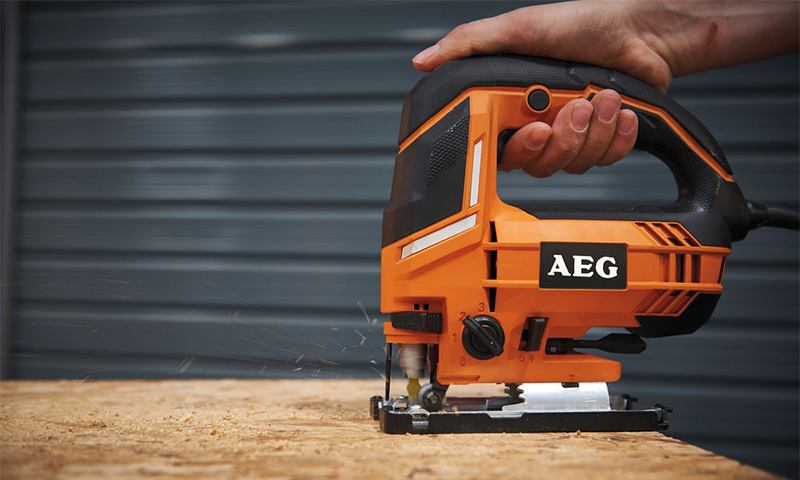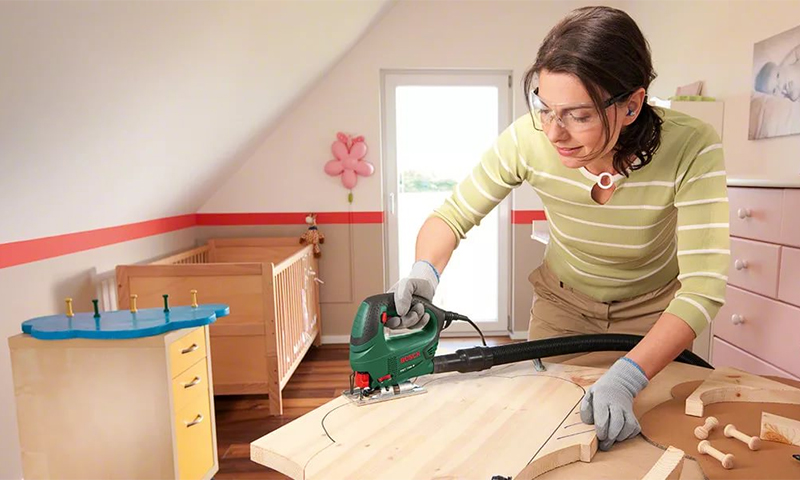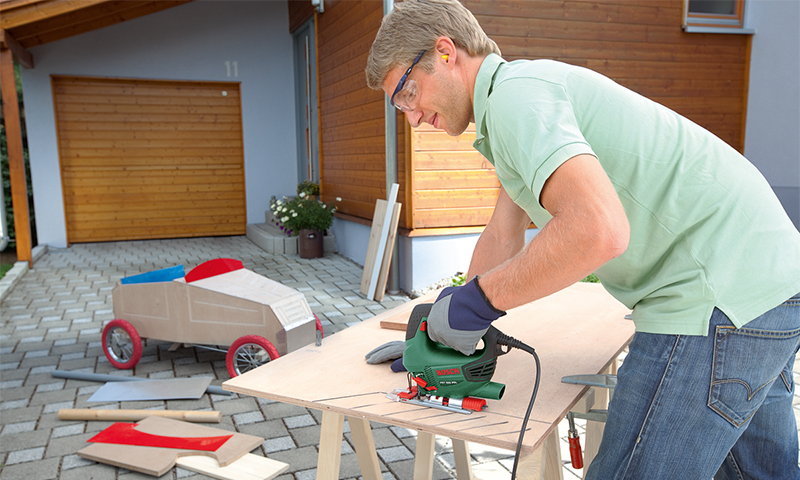One of the most popular cutting tools is a jigsaw, which makes it possible to make straight and curved cuts, and it does well both with wood and its derivatives, and with other materials: metal, ceramics, and gypsum cardboard. With the right choice, it will become an indispensable device and will save time and effort when working with any complexity. Before buying, you should examine in detail the types, as well as the capabilities of the tool, which will determine the performance and quality of the workflow.

Content:
The best manufacturers of jigsaws - which company to choose
When choosing a jigsaw, everyone thinks about how to choose a reliable tool with wide capabilities and at an affordable cost.
If there is no time to study in detail the differences of jigsaws, then it is recommended to pay attention to the products of brands, the quality of which has long been confirmed by users:
- Bosch;
- DeWALT;
- Phiolent;
- Makita;
- Interskol.
To learn more about the capabilities of the tools from these manufacturers, you can in ranking best jigsaws. But, nevertheless, in order for the product being purchased to meet your requirements as much as possible, it is better to find a few free minutes and carefully study all the performance data.
The principle of operation and device jigsaw

The jigsaw, unlike other types of cutting tools, is distinguished by high cutting precision with minimal loss of working material.
This quality of work provides quite a simple device device, which includes the following elements:
1. Electrical engine;
2. Gearbox;
3. Stock;
4. File;
5. Guide support plane.
The principle of the tool is to transfer mechanical electricity through the gearbox to the rod, which moves the file up and down fast translational movements perpendicular to the plane to be processed.
On average, the speed of the file is 53 strokes per second. The accuracy of the cut is provided by the support plane of the jigsaw, set at the required angle of inclination. Some models are additionally equipped with a supporting sponge or roller that corrects the movement of the file.
Jigsaw types
When choosing a jigsaw for home use, you must remember that they, like other electric tools, are divided into household and professional. These species differ significantly in their capabilities, which determine completely different productivity and resource of work.
There are also industrial jigsaws, but, as a rule, they are used in woodworking, furniture, as well as other enterprises, and are fundamentally different from their fellows of other classes, with impressive size and power.
Household

Household jigsaws have a small power up to 500 watts and low productivity. The permissible range of working hours for such models does not exceed 20 hours per month. Therefore, household jigsaws are used for short work on cutting wood with a thickness of up to 70 mm and steel sheets up to 4 mm.
Advantages:
- affordable price;
- wide range of;
- low weight
Disadvantages:
- limited resource;
- the inability to work with a material of great thickness.
In addition, household models have a small set of additional functions that can greatly facilitate the work with the device.
Professional

The power of professional jigsaws can reach 750 W and more, which allows them to be used for cutting wood with a thickness of about 130 mm, aluminum no more than 20 mm and steel up to 10 mm.The time of daily operation of such models is 8 hours, while they can be used continuously for 2-3 hours per day.
Advantages:
- the ability to process materials of different thickness;
- advanced functionality;
- increased work resource.
Disadvantages:
- large mass;
- high price of goods of famous brands.
Today you can find relatively inexpensive jigsaws made in China, but they are more suitable for the semi-professional class, and the quality of such products leaves much to be desired.
Jigsaw selection options

Any jigsaw has a number of performance, on which to rely when choosing. These include power, stroke frequency, cutting depth, etc. It is from them that the performance and service life of the tool will depend.
Power
The main features of the jigsaw is determined precisely by the power of the electric motor, which varies from 400 to 950 watts.
1. With a sawing wooden billet with a thickness of up to 80 mm or stainless steel up to 8 mm, an electric jigsaw with a capacity of 600 watts can easily handle. He is also considered the most running model.
2. For a thicker material, a more powerful tool will be needed, although with rare exploitation its acquisition would hardly be justified.
3. For light work with wood up to 65 mm or 4 mm steel, the 400-watt model is quite suitable, which can easily cope with other household tasks.
Stroke frequency
From the frequency of the course depends on the quality of the cut and the speed of the jigsaw.
Depending on the modification, this parameter can vary from 500 to 3100 revolutions per minute.
1. A tool capable of working at a high stroke frequency is well suited for soft wood, but it does not cut thick materials well.
2. For hard woods, plastic and soft metal, it is best to purchase a jigsaw with a medium stroke frequency.
3. When cutting steel, high quality cuts can be achieved only using a jigsaw with low speed.
Many models are equipped with a function of adjusting the frequency of the stroke. This allows you to use one tool for working with different types of materials.
Depth of cut
This parameter depends on its power and determines which materials can be processed in thickness, which can be processed by a jigsaw. In this case, with the same model, the depth of cutting of different material will be very different, which is displayed in the documentation.
1. As a rule, in domestic models with a small capacity, the depth of cutting of a wooden blade does not exceed 70 mm, and that of steel to 4 mm.
2. The depth of the cut professional tools for steel is 10 mm, aluminum about 30 mm, and wood 100 mm or more.
Power type
Two variants of electric jigsaws are available for customers: mains and battery.
1. Mains are connected to a single-phase mains with a voltage of 220 V. These models are more common than the battery, but they have certain disadvantages: the workplace must be equipped with power supply and when used, freedom of action is limited by the length of the cord.
2. Unlike network models, rechargeable more mobile. Basically, jigsaws with a battery voltage of 18 or 10.8 V are on sale. But, you can find options for 12 and 14.4 V. The minus of battery models lies in a small working time from one battery charge. From which it follows that it is better to have a spare battery nearby, which is not always in the bundle of goods.
Additional functions
In addition to the basic parameters, when choosing a jigsaw, it is recommended to pay attention to additional functions that greatly simplify the process of working with this device and improve the quality of the cut.
These include:
1. Pendulum swing or swap. It is present on almost all modern models and allows the file to perform not only reciprocating motion vertically, but also horizontally. This function increases the cutting speed and can be adjusted depending on the required tasks.Pendulum move is needed when a large amount of work associated with a straight cut, in which quality plays a secondary role.
2. Adjusting the angle of the sole. It makes it possible to make a cut at any angle to the working surface, thereby increasing the range of tasks of the device. As a rule, for expensive models, this function is limited to only two positions, 0 ° and 45 °, while professional jigsaws have 4 or more of these.
3. Automatic speed support under load. Required when working with dense and hard-to-process materials, such as hardwood, metal. With a high load, the jigsaw always loses its momentum, but the function of supporting the revs keeps the cutting speed and protects the engine from overload.
4. Smooth start. Prevents a sharp jerk when you turn on the tool, which allows you to correctly start cutting the workpiece. The soft start function is required for work requiring high cutting accuracy.
5. Laser pointer. It only becomes necessary if there is no time to do preliminary markings. In this case, the laser beam will perform the function of a guide line.
In addition to these characteristics, when buying an electric jigsaw, you can pay attention to additional features such as blowing chips and lights. Blowing off chips will always keep the working surface clean, which is important when figure cutting. And the backlight makes it possible to work even in a poorly lit room.
Which jigsaw to choose

Purpose
1. For use once every few months, household models are quite suitable.
2. If the plans are regular use of a jigsaw, it is better to give preference to semi-professional or professional universal models with a wide speed range.
Speed adjustment
1. More advantageous will be modifications in which the speed of the saw blade is adjusted by pressing the start button.
2. In models where the speed is set by a special toggle switch just before starting work, there is less opportunity to perform figure cutting with high quality.
Sole
1. Stamped soles will ensure an even cut only on a large bearing area.
2. With a limited contact area, it is preferable to use a more reliable jigsaw with a cast, durable sole.
Sole angle
1. If the change of the angle of the sole is required infrequently, then it is possible to dwell on models with a special lever.
2. If it is necessary to change the angle more often, it is better to purchase goods, where the angle of inclination of the sole changes with a special key.
View of the handle
1. For work on a horizontal surface, well-shaped options are well suited, which are easy to manage and the cutting lines are better monitored with them.
2. Mushroom-shaped models are suitable for working on inclined surfaces.
How much is a jigsaw

1. The most affordable at cost are household electric jigsaws, the price of which varies within the range of 2,250-15,000 rubles.
2. Network models with a minimum of functions will cost an average of 3,500 rubles. For the presence of the additional option of the pendulum stroke or backlight will have to pay about 5,000 rubles.
3. Accumulator models of the instrument of the same class will cost a bit more expensive - from 4,000 to 7,000 rubles.
4. The cost of professional jigsaws for network connection is much more expensive and starts from 6800 rubles, while battery-powered models with similar functionality will cost 10,000 rubles and above.
5. Equally important is the brand. A tool from the brand Makita and Fiolent is considered affordable. The most expensive are the Bosch and Hitachi jigsaws.
It will be interesting to friends too







